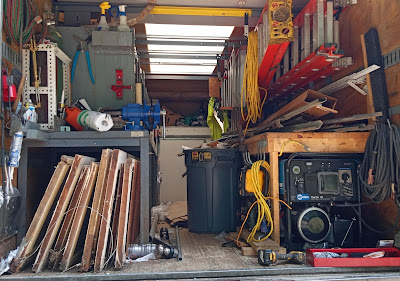Reflections - God Made It a Janet Quilt
Years ago, we’d tweaked her “Cup of Coffee” story about her first date with Adam. Ever since that Christmastime date, I’d followed her tentative steps toward establishing a stronger relationship. “What if I lose my one chance at true happiness?” she’d said, allowing herself cautious joy.
Taking my cue from her face and voice, I set aside the writing task for our screen-meeting and asked, “Do you have news to share?”
“Adam and I are getting married!”
We shrieked.
“Don’t say anything yet.” She blushed. “We want to tell the children when we all get together next month.”
“Will you have a Christmas wedding?” Maggie’s annual Christmas stories immersed me in scenes of her cup of coffee anniversary celebrations with Adam.
“No. Labor Day weekend when everyone can travel.”
My mind launched into planning mode. I would make Maggie a wedding quilt. Since she was half Irish, I chose the double Irish chain pattern, a design I’d set my heart on sewing someday.
For six weeks, I browsed the internet gazing at quilt photos. Two color chains diagonally crisscrossed white squares in the traditional pattern. Flowers or animal prints filled the plain squares in variations. And during subsequent writing sessions, I checked colors in the room behind Maggie—muted grays and tans.
After their family meeting, Maggie gushed. “Adam’s children and mine are delighted we’re getting married! They’re helping us plan the wedding around a wildflower theme.”
Wildflower fabrics for the chain and a green or tan for the white part would make a lovely quilt. Or I could use wildflowers for the white part with greens and tans for the chain. I sketched and calculated yardage for both designs. The quilt would match Maggie’s wedding theme and the room she sat in for our writing meetings.
Early Friday morning, March 17, Sandi—a neighbor friend, township auditor, and quilter—picked me up for a trip to the Fox’s Sew and Vac spring yard sale. We chatted the whole way to Meadville. There’s never a quiet moment with Sandi.
At the mall a cacophony of voices echoed in the hallway. Amish and English women—middle age and older, who didn’t work on Friday mornings—crowded around tables. Two or three deep, women hunted through piles of fabric remnants. We squeezed in.
Sandi searched for pieces she could add to her grandchildren's quilts—cows, cats, penguins, and horses.
“How about this?” I asked, holding a cute tan kitten?
Sandi frowned. “Wrong color.”
We kept searching, never finding tiny flowers for the chains. I came across daisies on a gold background and fell in love. Daisies are my favorite flower, and the remnant had just enough fabric for the white squares if I framed them in the dark green we found on another table.
Inside Fox’s store, Sandi helped me choose light green and tan fabrics to make the chains. We sat at the instruction table to rest our feet and make final calculations of how much yardage to buy. As we had during auditing, Sandi with her calculator and me with mine, we checked each other’s figures. More than once our numbers differed—usually Sandi had the right yardage.
I found a silver-gray tan material for the backing and calculated yardage while Sandi looked for horse prints—the only fabric she hadn’t found.
Weary but delighted with our treasurers, Sandi and I enjoyed a lunch out.
 |
| Fabrics for Maggie's Quilt |
Back home by late afternoon, I overcast the cut edges of the new fabric to keep it from unraveling. Overcasting the fabric for the quilt backing, I gasped and reached for the tape measure. I hadn’t bought enough. Tired from shopping, I’d goofed. YIKES! The yard sale continued tomorrow and . . .
Stuffing the fabric in a bag, I hustled down the spiral stairs and yelled to Spence. “I’m going to Fox’s. They close at five.”
“What’s the rush?”
“I didn’t get enough backing.” I grabbed my purse and keys. “I need more material before they sell the rest on the bolt.”
“Okay.” He drew the word out slowly. “If you think it’s important. Be careful.”
I dashed to the garage, drove faster than expected for my age, and arrived at Fox’s in record time.
Tracy and Jackie, employees and the only people in the store, chatted behind the counter. They rewrapped fabric around cardboard bolts.
Jog-wobbling to the counter, I pulled the silver-gray tan fabric out of the bag. “I didn’t get enough backing.” My voice came out in pants. “I need another yard.”
Jackie pivoted from the counter. “I’ll get it off the shelf.”
She returned and set the bolt of fabric—thinner than it had been that morning—beside my piece. “That’s a match.” A satisfied grin lit her face.
Tracy unwrapped the material and stretched it against the yardstick embedded in the table.
“Cut a yard and a quarter.” I bit my thumb nail. “I want a little extra . . . in case.”
Taking calming yoga breaths, I walked out of the store ten minutes before closing.
Having preshrunk the material, I studied directions for the two basic blocks. The Directory of Quilting Techniques book described the assembly of the block composed of 5 two-inch squares by 5 two-inch squares clearly. I could use those directions for my 5 by 5 blocks.
 |
| Quilt Book |
 |
| Directions for Double Irish Chain |
The YouTube video seemed easier for the white blocks—my framed daisies. The instructor’s “Make a single seam on the side” stuck in my mind. She’d said, “No need to put in the extra seams.” I could follow her directions for the daisy blocks.
I framed the cheerful daisies first. Sewing the top and bottom dark green frame first, let me make only one seam on the side. I cut, sewed, and overcast the raw edges of each seam. The fabric won’t fray when Maggie washes her quilt.
April 19, I had all thirty-one daisy blocks finished and four of the 5 by 5 blocks complete. I sat to answer a letter from Pat, a friend from Cleveland. Though I had described the double Irish chain quilt pattern to her in detail twice, Pat asked,
Is the double Irish chain made with a channel overlaid on the white to separate the segments or are the individually formed white squares affixed to the channels, then secured together into a whole quilt? Guess who has no idea of classic quilting techniques.
Clueless about Pat’s “channels,” I decided not to explain the pattern in words again. Instead, I sketched the two quilt blocks on graph paper. I colored the chain squares tan and green. The other spaces I left white. In the letter, I wrote, “These are the basic blocks for a traditional double Irish chain quilt. I’ve adapted mine. The white part has daisies in the middle. The rest of the white is a dark green for a frame.”
While walking to the mailbox with the letter, my mind imagined the blocks side by side and screamed DUH. Raising the flag on the mailbox for the letter carrier, I trudged back to the loft and pulled out my blocks.
I’d made a fatal error.
By sewing one side seam, I hadn’t inserted the corner tan squares needed for the chain motif. The upbeat YouTube instructor had done that step off screen. I’d remembered her words, not the image. Fixing my problem required ripping out the four corners in all thirty-one blocks. I’d overcast every seam. I couldn’t rip them without destroying some blocks, and I didn’t have enough daisy fabric left to resew ruined blocks.
Disaster!
How could I save my double Irish chain quilt? Panicked, I called Sandi.
Hearing the tremble in my voice, she said, “I’ll come up.”
Standing beside my sewing table, Sandi arranged the blocks in different positions. “It’s not an Irish chain any more.”
I knew that. Hearing Sandi pronounce the fact aloud, my soul dropped into the depths of despair like Anne’s had in Anne of Green Gables. What would I do for Maggie’s present? I wanted to make her a double Irish chain. I didn't have the time or energy to start over.
“The colors are beautiful. Don’t rip the daisy blocks out. Finish the quilt.” Sandi patted my shoulder. “God made it a Janet quilt.”
End of Part 1

Graph for Two Double Irish Chain Blocks




